
views
- Buff out light scratches with a baking soda and water paste or Bar Keepers Friend.
- For deep scratches, use wet 400-grit sandpaper or a coarse scouring pad dipped in olive oil.
- After removing a scratch, wipe down the stainless steel with a microfiber cloth and some oil to polish it.
Buffing Light Scratches

Determine the direction of the stainless steel’s grain. All stainless steel products have small parallel lines running across their surfaces; these lines are the steel’s grain. Look closely at the steel to see whether the grain runs horizontally from side to side or vertically up and down. When you clean and polish stainless steel, you rub back and forth in the same direction as the grain. Going against the metal’s grain or rubbing in circles can worsen the scratches. Clean your stainless steel appliances and cookware as soon as you notice they’re dirty. Giving them a regular wipe-down helps prevent buildup that can lead to discoloration and even scratches.

Clean the steel's surface with dish soap or a stainless steel cleaner. Removing dirt and grime before you buff out the stainless steel’s scratches prevents any additional damage and gives you a smooth surface to work on. Just wipe the steel down in the direction of its grain with a soft sponge or microfiber cloth and warm soapy water. Or, spray it with a stainless steel cleaner. Check your stainless steel’s user manual to see if it has a protective clear coat on it. The following scratch-removal tips work for stainless steel that isn’t coated. If your stainless steel has a protective coat, your best bet for repairing scratches is to polish it with a stainless steel polisher.

Choose a non-abrasive cleaner to buff out the scratches. The great thing about removing scratches from stainless steel is that several household compounds and cleaners fill in and smooth them out. Baking soda and non-gel whitening toothpaste work just as well as cleaners like Bar Keepers Friend and Perfect-It Rubbing Compound.
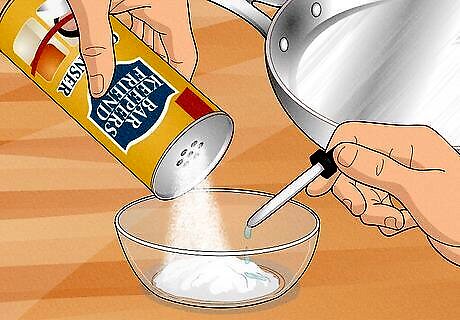
Mix the powdered cleaners into a paste with water. If you’re using a powdered cleaner like baking soda or Bar Keepers Friend, turn it into a paste before you apply it on the steel’s scratches. Just mix 1 tablespoon (14 g) of either powder with a few drops of water in a bowl. Stir the ingredients together to combine them, adding a few more drops of water as needed until you have a smooth paste. If you add too much water, just add a little sprinkle of powder. You’re going for a paste with the consistency of toothpaste.

Rub the cleaner or paste into the scratch in the direction of the grain. Spoon about a quarter of the paste onto a clean microfiber cloth. If you’re using a liquid cleaner, pour or spray a few drops of it onto a cloth. Then, use gentle, straight strokes to rub either cleaner into the scratch, working in the same direction as the stainless steel’s grain. Toothpaste: If you’re using toothpaste, squeeze a dollop of non-gel whitening toothpaste on a microfiber cloth and rub it into the scratch. Because the compound isn't abrasive, it’s okay to rub back and forth over the scratch. Do not rub in circles though, as this can damage the surface further.

Wipe off the excess cleaner with a damp and then dry cloth. Wet a clean microfiber cloth with water and wring it out so it’s barely damp. Simply wipe the surface of the stainless steel with the cloth to remove the remaining cleaner. Then, take a clean, dry cloth and wipe the surface to dry it off.

Examine the metal’s surface and rub in more cleaner if needed. Closely inspect the stainless steel to see if you fully removed the scratches. If you still see some damage, repeat the buffing process to get it out. If the scratches are still visible after cleaning it again, they might be deep and need a more abrasive solution to get them out. If your scratch is all gone, move on to polishing it using the steps described in the sections below.
Sanding Down Deeper Scratches
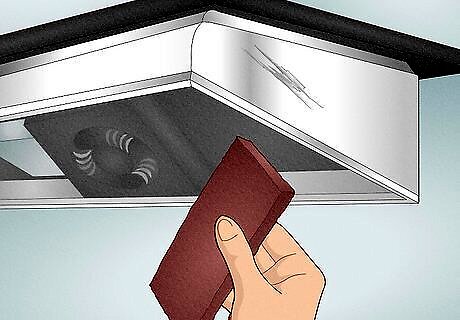
Choose an abrasive product to sand out deep scratches. If your stainless steel has deep scratches on the surface, it just takes a little bit of elbow grease to buff and sand them out. Either use 400-grit sandpaper or a coarse, maroon scouring pad. These materials are abrasive enough to remove the scratches but gentle on the metal so it isn’t damaged further. EXPERT TIP Filip Boksa Filip Boksa House Cleaning Professional Filip Boksa is a House Cleaning Professional and the CEO and Founder of King of Maids, a company based in Chicago, Illinois. With over 10 years of professional experience, Filip and his team at King Maids specialize in providing home cleaning and organization services to their clients. They are dedicated to delivering high-quality and reliable service to ensure customer satisfaction. Filip Boksa Filip Boksa House Cleaning Professional Alternatively, use a scratch removal kit. Stainless steel repair kits are often the best way to remove scratches. Just mix 2 tablespoons of the compound that comes with the kit with 4 or 5 drops of water. Then, rub it into the scratch using the provided scrubbing pads or cloths.

Lubricate the sanding product with water or oil. Wetting the sandpaper or scouring pad helps them glide over the stainless steel and minimizes any potential damage. If you’re using sandpaper, soak it in a bowl full of water for 1 to 2 minutes. If you’re using a scouring pad, pour on a few drops of olive oil. Scratch removal kits: If you’re using a kit, follow the directions for preparing the scouring materials.

Rub the scratch with the pad or sandpaper, following the metal’s grain. Use long, straight, back-and-forth strokes to go over the scratch with your oiled scouring pad or wet sandpaper. Rub in either material following the grain of the stainless steel and using gentle but even pressure. Do not use circular motions, as this can scratch up the metal’s surface even more. Look closely at the surface of the stainless steel to identify the movement of the grain. The small grain lines either run horizontally or vertically. Wrap the scouring pad or sandpaper around a wooden block to apply even pressure as you sand.

Repeat the sanding process with the finer pad or sandpaper. When the scratch is barely visible, switch to 600-grit sandpaper or a fine, gray scouring pad. This helps smooth and shine the surface of the stainless steel. Just soak the sandpaper in water for 1 to 2 minutes, or apply a few drops of olive oil onto the scouring pad. Then, sand over the scratch using long strokes and gentle, even pressure in the direction of the metal’s grain. Continue sanding until the scratch disappears.
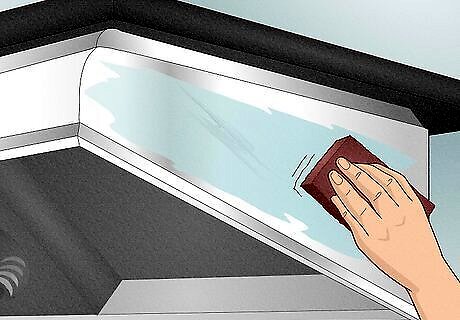
Sand the rest of the stainless steel to make it smooth and scratch-free. If you just sand the scratches on the stainless steel, you’ll be left with a section that’s visibly smoother than the rest of the metal’s surface. So, gently rub the entire surface of the stainless steel with your finer-grit scouring pad or sandpaper. If either material has lost its lubrication, just re-wet or oil it. Depending on the size of your stainless steel, it can take several minutes to sand it completely.
Cleaning and Polishing the Steel
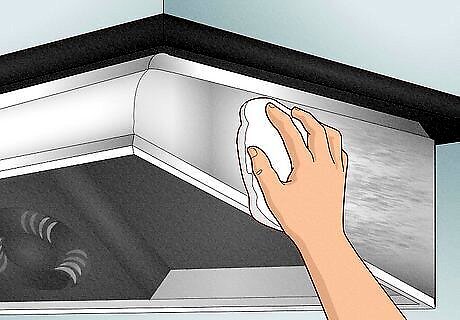
Wipe the metal with a microfiber cloth to remove leftover debris. After getting out a light or deep scratch, take a clean, dry microfiber cloth and rub it back and forth in the direction of the stainless steel’s grain. If you had a deep scratch, this removes any leftover dust. It also buffs out the cleaning compound you used for either type of scratch.
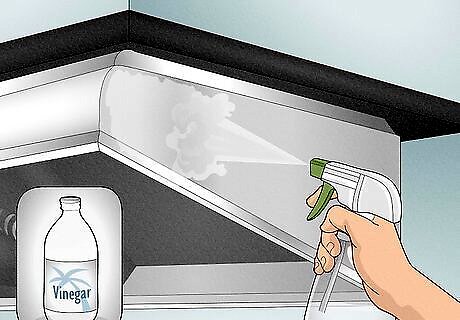
Clean the entire surface with distilled white vinegar. To fully remove any leftover cleaning paste and oil, spray the surface of your stainless steel with distilled white vinegar. Then, use a clean, dry microfiber cloth to wipe the metal in the direction of its grain. Do not use bleach, oven cleaner, or abrasive pads when cleaning stainless steel.
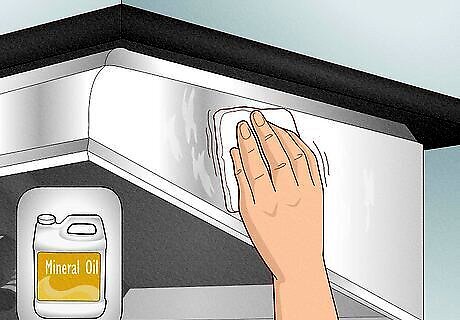
Polish the stainless steel with oil. To restore the shine on your stainless steel, just wipe it down with some mineral, vegetable, or olive oil. Simply dip a clean, dry microfiber cloth into a tiny amount of the oil of your choice. Then, rub it in the direction of the metal’s grain. Use a little bit of oil at first, as you can always add more onto your cloth to get your steel shining.
Preventing Scratches
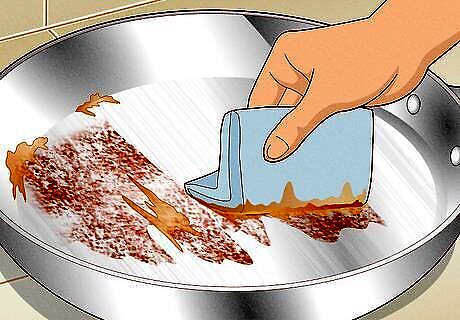
Clean up messes as soon as possible and follow the grain of the metal. Letting food debris and dirt solidify on stainless steel can make them harder to clean up, leaving the metal more prone to scratches when you have to scrub them off. So, make it a habit to regularly clean off your stainless steel. Just use a soft, microfiber cloth and wipe back and forth in the direction of the metal’s grain.
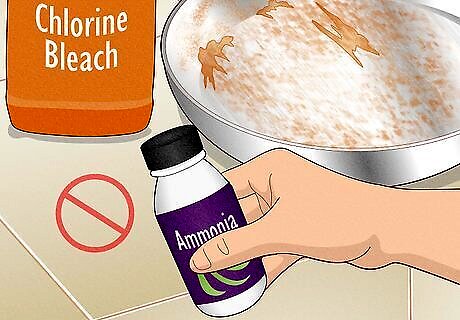
Stay away from harsh cleaners like ammonia and chlorine bleach. Abrasive household cleaners often damage stainless steel, causing unsightly spots of rust and even scratches. Stick to gentle cleaners like distilled white vinegar and dish soap when cleaning stainless steel. Or, use commercial stainless steel cleaners. Avoid harsh scrubbers like steel wool when cleaning stainless steel. While fine-grit pads buff out scratches, abrasive scrubbers can create them. If you have a stainless steel sink, don’t pour harsh cleaners and paint strippers down it. These compounds can also cause damage and scratches.
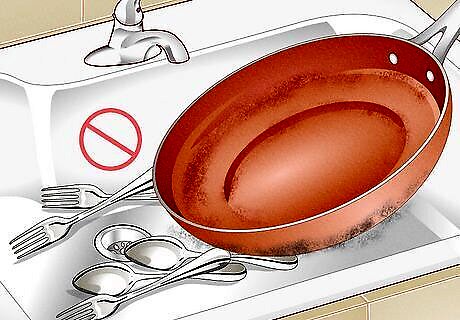
Protect stainless steel surfaces from metal utensils and pans. While stainless steel is durable, other metal kitchen utensils, pots and pans, and tools can scratch and damage it. So, always use a cutting board when chopping up food on your stainless steel surfaces. If you have a stainless steel sink, don’t leave your utensils and dishes inside to prevent stains and scratches from forming, too. Hot pots and pans can also cause damage. Place them on pot holders instead of setting them directly on your stainless steel surface or sink.
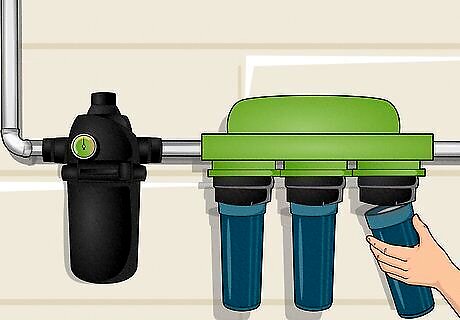
Install a water-softening system if you have hard water. Hard, mineral-rich water often leaves unsightly stains on stainless steel surfaces. To keep your surfaces shiny, polished, and scratch-free, add a soft water filter to your sink to remove the staining minerals in your hard water. Or, install a soft water treatment system to your entire house. If it isn’t feasible for you to install a water-softening system, simply dry off your stainless steel surfaces with a microfiber cloth after you clean or use them.




















Comments
0 comment